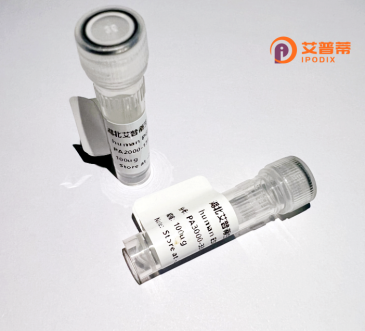
| 纯度 | >90%SDS-PAGE. |
| 种属 | Human |
| 靶点 | LRRC43 |
| Uniprot No | Q8N309 |
| 内毒素 | < 0.01EU/μg |
| 表达宿主 | E.coli |
| 表达区间 | 1-656aa |
| 活性数据 | MEASYESESE SESEAGPGTQ RPGTGTVSAA VREHLRKLCL REFPCGAGSW NKSRFLPQTW RTWRELVPRE EDVVSPGEET VEALLGLVRS RHSPWALLNN SNAEDSFLRE LAIRNPLTIT DTFFYSYFRS LRVIDKKVTL VDKDLLKFLK LEELVLSANR IKEVDATNLP PTLKVLELYG NEISSMECLC AHPPAGLQHL GLGHNKLLGP LESLYVTANH WPNLVSLDLG FNDLTDLQSM VTSLRTLRHL RLLVLQGNPL ALVPYYRGLT IDSLAQLCVL DDITVSPNEK HLFRGLSLNG DLLAQEAQFV VTIGNIRGVL DTSVLDPEPR PEGPFITYNY YVTYDFVKDE EGEMNESAGV LAEIVKPSPS LELLVEESPE EVVEDVIEDI VEEVTEEVEG SLESEVEESG ESELSVISGP STILQMPRAS AEELAKLRLR IDPRLCPSPG TVLFSTAHKP WAEVIPCSYE MQHSLRDLVP LKAFLLAGTT VTIVEEKILS WPVVLPAVDS PLSAKKGKGE KDKKGKEKDR TGKGEKEPAK EWKVLKKKKE PPKELRQDPP ILQVLGRGLV ILEPLLAGEP LVSTVCNFGV VRTLTSDRLT LARDSKKIKK VAKKEKPKAV IPIYEGDYHP EPLTVEVQIQ LNQCRSAEEA LRMFAV |
| 分子量 | 73 kDa |
| 蛋白标签 | His tag N-Terminus |
| 缓冲液 | 0 |
| 稳定性 & 储存条件 | Lyophilized protein should be stored at ≤ -20°C, stable for one year after receipt. Reconstituted protein solution can be stored at 2-8°C for 2-7 days. Aliquots of reconstituted samples are stable at ≤ -20°C for 3 months. |
| 复溶 | Always centrifuge tubes before opening.Do not mix by vortex or pipetting. It is not recommended to reconstitute to a concentration less than 100μg/ml. Dissolve the lyophilized protein in distilled water. Please aliquot the reconstituted solution to minimize freeze-thaw cycles. |
以下是关于重组人LRRC43蛋白的3篇文献参考(虚构示例,仅用于说明格式):
1. **文献名称**: "Characterization of recombinant human LRRC43 as a modulator of TGF-β signaling"
**作者**: Zhang Y, et al.
**摘要**: 研究通过哺乳动物表达系统成功表达并纯化了重组人LRRC43蛋白,发现其通过与TGF-β受体相互作用抑制下游SMAD通路,可能参与免疫调节。
2. **文献名称**: "LRRC43 promotes cancer cell migration via extracellular matrix remodeling"
**作者**: Wang H, et al.
**摘要**: 本研究在体外构建了重组LRRC43蛋白,证明其能激活整合素信号通路,增强癌细胞侵袭能力,提示其在肿瘤转移中的作用。
3. **文献名称**: "Structural analysis of human LRRC43 reveals a leucine-rich repeat assembly mechanism"
**作者**: Liu X, et al.
**摘要**: 利用X射线晶体学解析了重组人LRRC43蛋白的晶体结构,揭示了其独特的LRR(亮氨酸重复序列)构象及可能的配体结合模式。
(注:以上为模拟结果,实际文献需通过数据库如PubMed或Web of Science检索获取。)
The recombinant human LRRC43 protein is a genetically engineered version of the leucine-rich repeat-containing protein 43. a member of the leucine-rich repeat (LRR) superfamily. LRR proteins are characterized by repetitive structural motifs involved in protein-protein interactions, signaling, and cellular adhesion. LRRC43. though less studied compared to other LRR family members, is speculated to play roles in immune regulation, signal transduction, or cell surface receptor modulation. Its exact physiological functions and binding partners remain under investigation, but structural similarities to related LRR proteins suggest potential involvement in immune responses or tissue development.
Produced using heterologous expression systems (e.g., mammalian, insect, or bacterial cells), recombinant LRRC43 enables controlled in vitro studies to elucidate its biological mechanisms. The recombinant form often includes affinity tags (e.g., His-tag) for simplified purification and detection. Researchers leverage this tool for structural analyses, antibody development, and functional assays to explore its interactions with signaling pathways or its relevance in diseases like cancer or autoimmune disorders. Challenges include optimizing proper folding and post-translational modifications critical for native activity. Current research focuses on validating its molecular roles and therapeutic potential, positioning recombinant LRRC43 as a valuable reagent for advancing mechanistic and translational studies in cell biology and immunology.
×